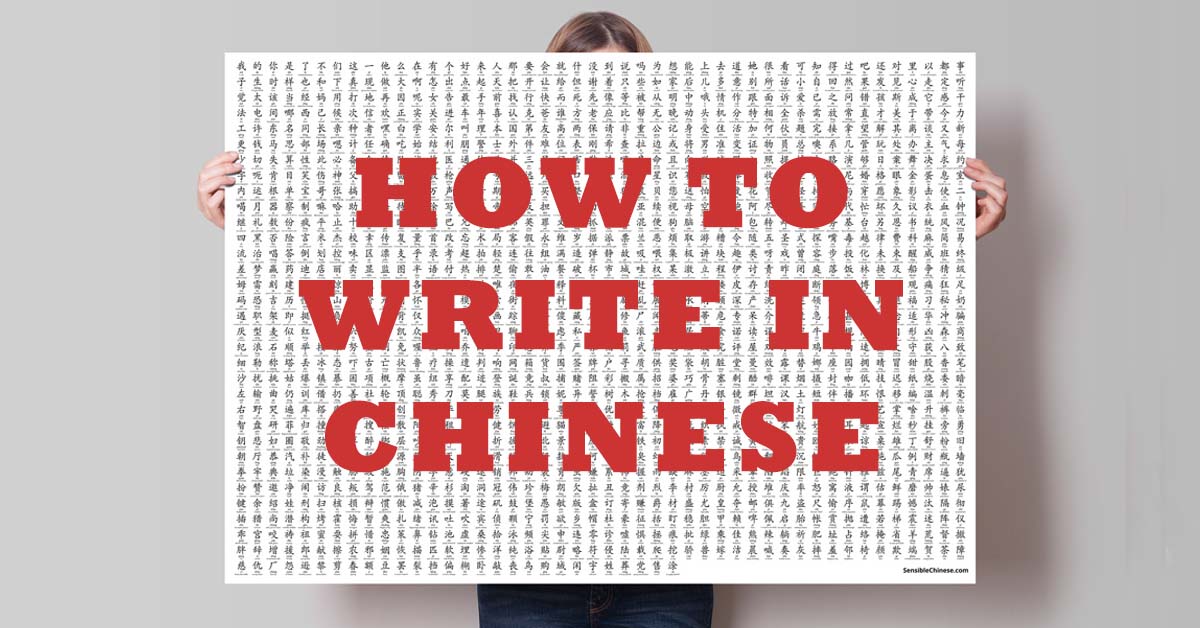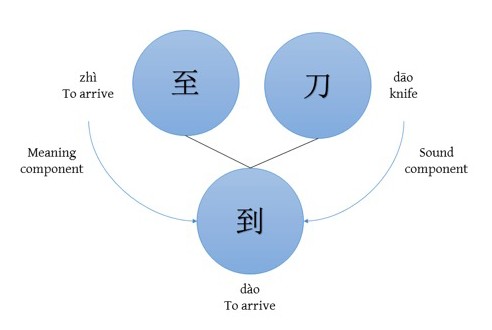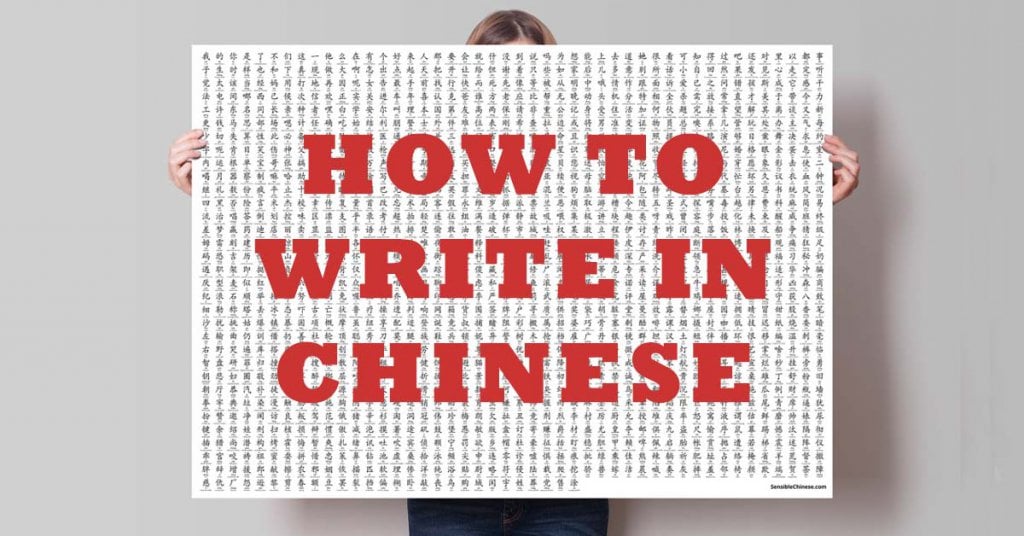
You probably think learning how to write in Chinese is impossible.
And I get it.
I’m a native English speaker, and I know how complex Chinese characters seem.
But you’re about to learn that it's not impossible.
First, you’ll learn the basics of how the Chinese written language is constructed. Then, you’ll get a step-by-step guide for how to write Chinese characters sensibly and systematically.
Wondering how it can be so easy?
Then let’s get into it.
Don't have time to read this now? Click here to download a free PDF of the article
Pro Tip
By the way, if you want to learn Chinese fast (including how to write in Chinese), my top recommendation is Chinese Uncovered which teaches you through StoryLearning®.
With Chinese Uncovered you’ll use my unique StoryLearning® method to learn Chinese through story… not rules. It’s as fun as it is effective.
If you’re ready to get started, click here for a 7-day FREE trial.
Table of Contents
How To Write In Chinese
Chinese is a complex language with many dialects and varieties.
Before we dive into learning how to write in Chinese, let’s just take a second to be clear exactly what we’ll be talking about.
First, you’ll be learning about Mandarin Chinese, the “standard” dialect. There are 5 main groups of Chinese dialects and perhaps 200 individual dialects in China & Taiwan.
Mandarin Chinese is the “standard” used in Beijing and spoken or understood, by 2/3 of the population.
Second, there are two types of Chinese characters: Traditional and Simplified. In this article, we’ll be talking about Simplified Chinese characters, which are used in the majority of Mainland China.
There is an ongoing politicised debate about the two kinds of characters, and those asking themselves: “Should I learn traditional or simplified Chinese characters?” can face a difficult choice.
- For more on difference between Simplified and Traditional characters read this article
- To learn more about “the debate” read this excellent Wikipedia article
- If you want to switch Simplified characters into Traditional, you might like the fantastic New Tong Wen Tang browser plugin
First Steps In Learning Chinese Characters
When learning a European language, you have certain reference points that give you a head start.
If you're learning French and see the word l'hôtel, for example, you can take a pretty good guess what it means! You have a shared alphabet and shared word roots to fall back on.
In Chinese this is not the case.
When you're just starting out, every sound, character, and word seems new and unique. Learning to read Chinese characters can feel like learning a whole set of completely illogical, unconnected “squiggles”!
The most commonly-taught method for learning to read and write these “squiggles” is rote learning.
Just write them again and again and practise until they stick in your brain and your hand remembers how to write in Chinese! This is an outdated approach, much like reciting multiplication tables until they “stick”.
I learnt this way.
Most Chinese learners learnt this way.
It's painful…and sadly discourages a lot of learners.
However, there is a better way.
Even without any common reference points between Chinese and English, the secret is to use the basic building blocks of Chinese, and use those building blocks as reference points from which to learn how to write in Chinese.
This article will:
- Outline the different levels of structure inherent in Chinese characters
- Show you how to build your own reference points from scratch
- Demonstrate how to build up gradually without feeling overwhelmed
The Structure Of Written Chinese
The basic structure of written Chinese is as follows:
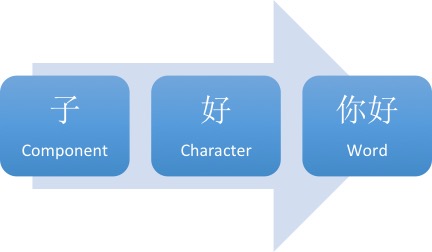
I like to think of Chinese like Lego… it's very “square”!
The individual bricks are the components (a.k.a radicals).
We start to snap these components together to get something larger – the characters.
We can then snap characters together in order to make Chinese words.
Here's the really cool part about Chinese: Each of these pieces, at every level, has meaning.
The component, the character, the word… they all have meaning.
This is different to a European language, where the “pieces” used to make up words are letters.
Letters by themselves don't normally have meaning and when we start to clip letters together we are shaping a sound rather than connecting little pieces of meaning. This is a powerful difference that comes into play later when we are learning vocabulary.
Let's look at the diagram again.
Here we start with the component 子. This has the meaning of “child/infant”.
The character 好 (good) is the next level. Look on the right of the character and you'll see 子. We would say that 子 is a component of 好.
Now look at the full word 你好 (“Hello”). Notice that the 子 is still there.
- The character 好 is built of the components 女 and 子.
- The character 你 is built from 人 + 尔.
- The word 你好 in turn is constructed out of 你 + 好.
Here's the complete breakdown of that word in an easy-to-read diagram:
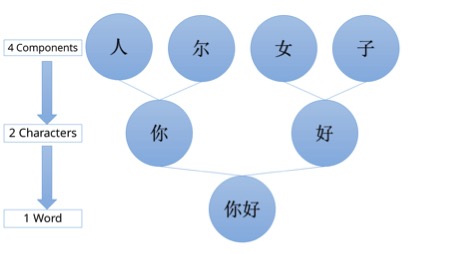
Now look at this photo of this in real life!
Don't worry if you can't understand it. Just look for some shapes that you have seen before.

The font is a little funky, so here are the typed characters: 好孩子
What components have you seen before?
Did you spot them?

This is a big deal.
Here's why…
Why Character Components Are So Important
One of the big “scare stories” around Chinese is that there are 50,000 characters to learn.
Now, this is true. But learning them isn't half as bad as you think.
Firstly, only a few thousand characters are in general everyday use so that number is a lot more manageable.
Second, and more importantly, those 50,000 characters are all made up of the same 214 components.
And you already know one of them: 子 (it's one of those 214 components).
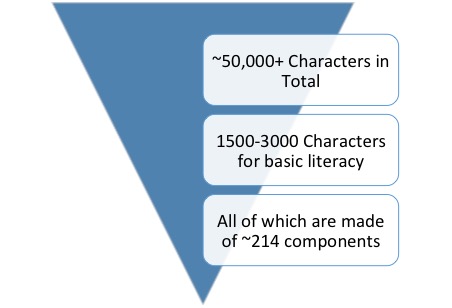
The fact that you can now recognise the 子 in the image above is a huge step forward.
You can already recognise one of the 214 pieces all characters are made up of.
Even better is the fact that of these 214 components it's only the 50-100 most common you'll be running into again and again.
This makes Chinese characters a lot less scary.
Once you get a handle on these basic components, you'll quickly recognise all the smaller pieces and your eyes will stop glazing over!
This doesn't mean you'll necessarily know the meaning or how to pronounce the words yet (we'll get onto this shortly) but suddenly Chinese writing doesn't seem quite so alien any more.
Memorising The Components Of Chinese Characters
Memorising the pieces is not as important as simply realising that ALL of Chinese is constructed from these 214 pieces.
When I realised this, Chinese became a lot more manageable and I hope I've saved you some heartache by revealing this early in your learning process!
Here are some useful online resources for learning the components of Chinese characters:
- If you like flashcards, there's a great Memrise course here.
- Wikipedia also has a sweet sortable list here.
TAKEAWAY: Every single Chinese character is composed of just 214 “pieces”. Only 50-100 of these are commonly used. Learn these pieces first to learn how to write in Chinese quickly.
Moving From Components To Chinese Characters
Once you've got a grasp of the basic building blocks of Chinese it's time to start building some characters!
We used the character 好 (good) in the above example. 好 is a character composed of the components 女 (woman) and 子 (child).
Unlike the letters of the alphabet in English, these components have meaning.
(They also have pronunciation, but for the sake of simplicity we'll leave that aside for now!)
- 女 means “woman” and 子 means “child”.
- When they are put together, 女 and 子 become 好 …and the meaning is “good”.
- Therefore “woman” + “child” = “good” in Chinese 🙂
When learning how to write in Chinese characters you can take advantage of the fact that components have their own meanings.
In this case, it is relatively easy to make a mnemonic (memory aid) that links the idea of a woman with her baby as “good”.
Because Chinese is so structured, these kind of mnemonics are an incredibly powerful tool for memorisation.
Some characters, including 好, can also be easily represented graphically. ShaoLan's book Chineasy does a fantastic job of this.
Here's the image of 好 for instance – you can see the mother and child.
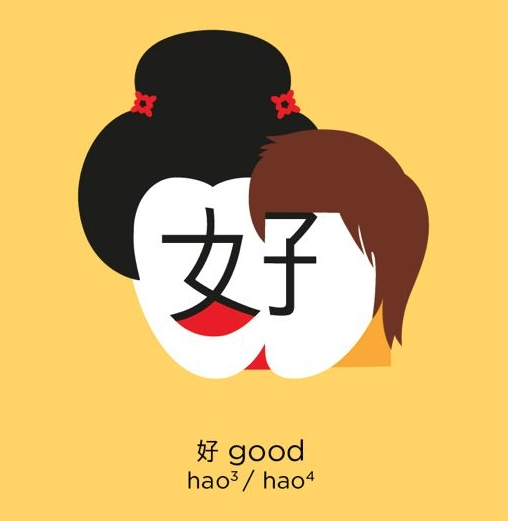
Visual graphics like these can really help in learning Chinese characters.
Unfortunately, only around 5% of the characters in Chinese are directly “visual” in this way. These characters tend to get the most attention because they look great when illustrated.
However, as you move beyond the concrete in the more abstract it becomes harder and harder to visually represent ideas.
Thankfully, the ancient Chinese had an ingenious solution, a solution that actually makes the language a lot more logical and simple than merely adding endless visual pictures.
Watch Me Write Chinese Characters
In the video below, which is part of a series on learning how to write in Chinese, I talk about the process of actually writing Chinese characters by hand.
Not thousands of times like Chinese schoolchildren. But just as a way to reinforce my learning and attack learning Chinese characters from different angles.
My Chinese handwriting leaves a lot to be desired. But it's more about a process of reinforcing my language learning via muscle memory than perfecting my handwriting.
You'll also hear me discuss some related issues such as Chinese stroke order and how to type in Chinese.
The Pronunciation Of Chinese Characters
Back to that solution for learning more abstract characters. The solution was the incredibly unsexy sounding… (wait for it…) “phono-semantic compound character”.
It's an awful name, so I'm going to call them “sound-meaning characters” for now!
This concept is the key to unlocking 95% of the Chinese characters.
A sound-meaning character has a component that tells us two things:
- the meaning
- a clue to how the character is pronounced
So, in simple terms:
95% of Chinese characters have a clue to the meaning of the character AND its pronunciation.
Example:
到 means “to arrive”.
This character is made of two components. On the left is 至 and on the right is 刀.
These are two of the 214 components that make up all characters. 至 means “to arrive” and 刀 means “knife”.
Any idea which one gives us the meaning? Yup – it's 至 (to arrive)! (That was an easy one 🙂 )
But how about the 刀? This is where it gets interesting.
到 is pronounced dào.
刀, “knife” is pronounced dāo.
The reason the 刀 is placed next to 至 in the character 到 is just to tell us how to pronounce the character! How cool is that?
Now, did you notice the little lines above the words: dào and dāo?
Those are the tone markers, and in this case they are both slightly different. These two characters have different tones so they are not exactly the same pronunciation.
However, the sound-meaning compound has got us 90% of the way to being able to pronounce the character, all because some awesome ancient Chinese scribe thought there should be a shortcut to help us remember the pronunciation!
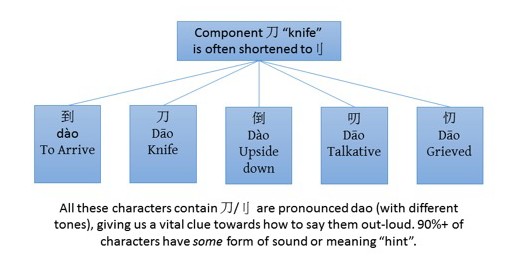
Let's look at a few more examples of how 刀 is used in different words to give you an idea of the pronunciation.
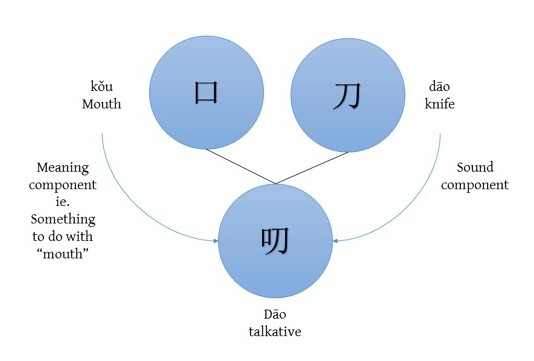
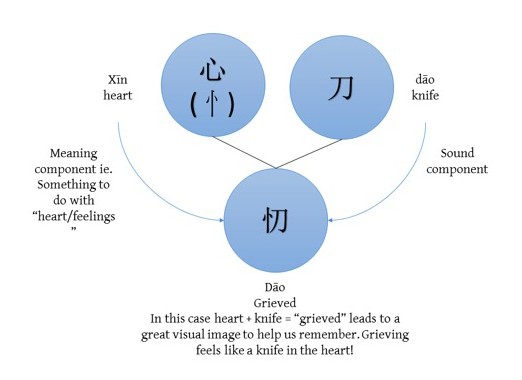
Even if sometimes:
- the sound-meaning character gives us the exact sound and meaning
- or it gets us in the ballpark
- or worse it is way off because the character has changed over the last 5,000 years!
Nevertheless, there's a clue about the pronunciation in 95% of all Chinese characters, which is a huge help for learning how to speak Chinese.
TAKEAWAY: Look at the component parts as a way to unlock the meaning and pronunciations of 95% of Chinese characters. In terms of “hacking” the language, this is the key to learning how to write in Chinese quickly.
From Chinese Characters To Chinese Words
First we went from components to characters.
Next, we are going from characters to words.
Although there are a lot of one-character words in Chinese, they tend to either be classically-rooted words like “king” and “horse” or Chinese particles and pronouns.
The vast majority of Chinese words contain two characters.
The step from characters to words is where, dare I say it, Chinese script gets easy!
Come on, you didn't think it would always be hard did you? 🙂
Unlike European languages Chinese's difficulty is very front-loaded.
When you first learn how to write in Chinese, you'll discover a foreign pronunciation system, a foreign tonal system and a very foreign writing system.
As an English speaker, you can normally have a good shot at pronouncing and reading words in other European languages, thanks to the shared alphabet.
Chinese, on the other hand, sucker-punches you on day one… but gets a little more gentle as you go along.
One you've realised these things:
- there aren't that many components to deal with
- all characters are made up of these basic components
- words are actually characters bolted together
…then it's a matter of just memorising a whole bunch of stuff!
That's not to say there isn't a lot of work involved, only to say that it's not particularly difficult. Time-consuming, yes. Difficult, no.
This is quite different from European languages, which start off easy, but quickly escalate in difficulty as you encounter complicated grammar, tenses, case endings, technical vocabulary and so on.
Making words from Chinese characters you already know is easy and really fun. This is where you get to start snapping the lego blocks together and build that Pirate Island!
The Logic Of Chinese Writing
Here are some wonderful examples of the simplicity and logic of Chinese using the character 车 which roughly translates as “vehicle”.
- Water + Vehicle = Waterwheel = 水 +车
- Wind + Vehicle = Windmill = 风+车
- Electric + Vehicle = Tram/Trolley = 电+车
- Fire + Vehicle = Train = 火+车
- Gas + Vehicle = Car = 汽+车
- Horse + Vehicle = Horse and cart/Trap and Pony = 马+车
- Up + Vehicle = Get into/onto a vehicle =上+车
- Down + Vehicle = Get out/off a vehicle =下+车
- Vehicle + Warehouse = Garage = 车+库
- To Stop + Vehicle = to park = 停+车
Chinese is extremely logical and consistent.
This is a set of building blocks that has evolved over 5,000 years in a relatively linear progression. And you can't exactly say the same about the English language!
Just think of the English words for the Chinese equivalences above:
Train, windmill, millwheel/waterwheel, tram/trolley, car/automobile, horse and cart/trap and pony.
Unlike Chinese where these concepts are all linked by 车 there's very little consistency in our vehicle/wheel related vocabulary, and no way to link these sets of related concepts via the word itself.
English is a diverse and rich language, but that comes with its drawbacks – a case-by-case spelling system that drives learners mad.
Chinese, on the other hand, is precise and logical, once you get over the initial “alienness”.
Making The Complex Simple
This logical way of constructing vocabulary is not limited to everyday words like “car” and “train”. It extends throughout the language.
To take an extreme example let's look at Jurassic Park.
The other day I watched Jurassic Park with my Chinese girlfriend. (OK, re-watched. It's a classic!)
Part of the fun for me (annoyance for her) was asking her the Chinese for various dinosaur species.
Take a second to look through these examples. You'll love the simplicity!
- T Rex 暴龙 = tyrant + dragon
- Tricerotops 三角恐龙 three + horn + dinosaur
- Diplodocus 梁龙 roof-beam + dragon
- Velociraptor 伶盗龙 clever + thief + dragon (or swift stealer dragon)
- Stegosaurus 剑龙 (double-edged) sword + dragon
- Dilophosaurus 双脊龙 double+spined+dragon
Don't try to memorise these characters, just appreciate the underlying logic of how the complex concepts are constructed.
(Unless, of course, you are a palaeontologist…or as the Chinese would say a Ancient + Life + Animal + Scientist!).
I couldn't spell half of these dinosaur names in English for this article. But once I knew how the construction of the Chinese word, typing in the right characters was simple.
Once you know a handful of characters, you can start to put together complete words, and knowing how to write in Chinese suddenly becomes a lot easier.
In a lot of cases you can take educated guesses at concepts and get them right by combining known characters into unknown words.
For more on this, check my Chinese character image below. It focuses on Chinese words constructed from common characters, and helps you understand more of the “building block” logic of Chinese.
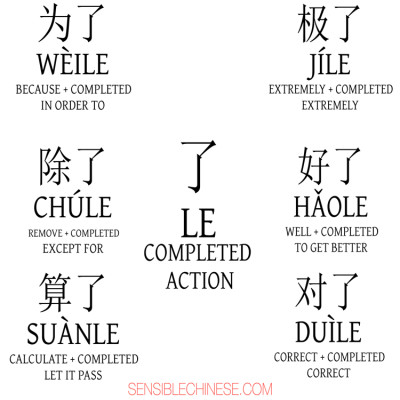
TAKEAWAY: Chinese words are constructed extremely logically from the underlying characters. This means that once you've learned a handful of characters vocabulary acquisition speeds up exponentially.
How To Learn Written Chinese Fast
Before diving into learning characters, make sure you have a decent grounding in Chinese pronunciation via the pinyin system.
The reason for this is that taking on pronunciation, tones and characters from day one is really tough.
Don't get me wrong, you can do it. Especially if you're highly motivated. But for most people there's a better way.
Learn a bit of spoken Chinese first.
With some spoken language under your belt, and an understanding of pronunciation and tones, starting to learn how to write in Chinese will seem a whole lot easier.
Right now, I'm going to get you started with the basics of how to write in Chinese.
The Sensible Character System
The four stages for learning how to write in Chinese are:
- Input
- Processing
- Review
- Usage
Sounds technical huh? Don't worry, it's not really.
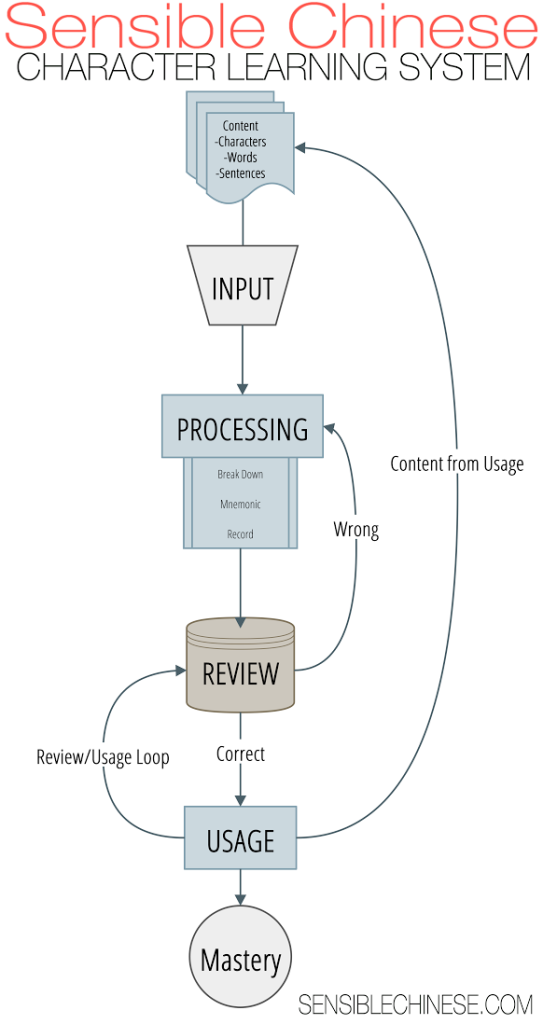
1. Input
This part of the process is about choosing what you put into your character learning system.
If you're working on the wrong material then you're wasting your efforts. Instead choose to learn Chinese characters that you are like to want to use in the future.
My list in order of priority contains:
- daily life: characters/words I've encountered through daily life
- textbooks: characters/words I've learnt from textbooks
- frequency lists: characters/words I've found in frequency lists of the most common characters and words
2. Processing
This is the “learning” part of the system.
You take a new word or character and break it down into its component parts. You can then use these components to create memory aids.
Hanzicraft.com or Pleco's built-in character decomposition tool are fantastic for breaking down new characters. These will be helpful until you learn to recognise the character components by sight. These tools will also show you if there are sound-meaning component clues in the character.
Use the individual components of a character to build a “story” around the character. Personal, sexy and violent stories tend to stick in the mind best! 🙂 I also like to add colours into my stories to represent the tones (1st tone Green, 2nd tone Blue etc.)
3. Review
After the “input” and the “process”… it's time to review it all!
The simplest review system is paper flashcards which you periodically use to refresh your memory.
A more efficient method can be found in software or apps that use a Spaced Repetition System, like Anki or Pleco.
An important point: Review is not learning.
It's tempting to rely on software like Anki to drill in the vocabulary through brute-force repetition. But don't skip the first two parts – processing the character and creating a mnemonic are key parts of the process.
4. Usage
It isn't enough to just learn and review your words… you also need to put them into use!
Thankfully, technology has made this easier than ever. Finding a language exchange partner or a lesson with a cost-effective teacher is super simple nowadays, so there's no excuse for not putting your new vocabulary into action!
The resources I personally use are:
Importantly, whilst you are using your current vocabulary in these forms of communication, you'll be picking up new content all the time, which you can add back into your system.
The four steps above are a cycle that you will continue to rotate through – all the corrections and new words you receive during usage should become material to add to the system.
To recap, the four steps of systematically learning Chinese characters are:
- Input
- Processing
- Review
- Usage
By building these steps into your regular study schedule you can steadily work through the thousands of Chinese characters and words you'll need to achieve literacy.
This is a long-haul process! So having a basic system in place is very important for consistency.
FAQ About How To Write In Chinese
How do you write Chinese writing?
Chinese writing uses characters (called 汉字 hànzì) rather than an alphabet. Each character represents a syllable and often a whole word or part of a word.
Characters are written in specific strokes following set stroke order rules, typically starting from top to bottom and left to right.
How Chinese words are written?
Chinese words are made up of one or more characters, each representing a syllable. For example, the word for “hello” (你好 nǐ hǎo) consists of two characters.
There is no alphabet, so each character must be memorized, though the Pinyin system helps learners by representing sounds using the Roman alphabet.
How can I write my name in China?
To write your name in Chinese, it is usually transliterated into Chinese characters that approximate the sound of your name. For example, John might be written as 约翰 (Yuēhàn).
Alternatively, some people choose a meaningful Chinese name that reflects their personality or preferences.
Is there a Chinese alphabet A to Z?
No, there is no alphabet in Chinese like A to Z. Instead, Chinese uses characters, each representing a syllable or word.
However, Pinyin, a Romanisation system, is used to teach pronunciation, and it does utilise the A to Z alphabet to spell out the sounds of Chinese words.
Top Links & Resources For Learning How To Write In Chinese
- 111 Mandarin Chinese resources you wish you knew – Olly’s huge list of the best Mandarin Chinese resources on the web for learning Chinese
I hope you enjoyed this epic guide to learning how to write in Chinese!

Olly Richards
Creator of the StoryLearning® Method
Olly Richards is a renowned polyglot and language learning expert with over 15 years of experience teaching millions through his innovative StoryLearning® method. He is the creator of StoryLearning, one of the world's largest language learning blogs with 500,000+ monthly readers.
Olly has authored 30+ language learning books and courses, including the bestselling "Short Stories" series published by Teach Yourself.
When not developing new teaching methods, Richards practices what he preaches—he speaks 8 languages fluently and continues learning new ones through his own methodology.
